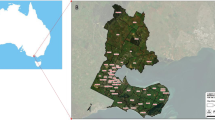Abstract
Landscape metrics are measurements of landuse patterns and land-use change, but even so, have rarely been integrated into land-use change simulation models. This paper proposes a new artificial neural network-cellular automaton by integrating landscape metrics into the model. In this model, each cell acquires unique landscape metric values. The landscape metric values of each cell are actually the landscape metric values of land use type in its neighborhood, which takes the cell as center. The calculation of landscape metrics ensures that those of each cell can represent cellular spatial environmental characteristics. The model is used to simulate land use change in the Changping district of Beijing, China. Comparisons of the simulated land use map with the actual map show that the proposed model is effective for land use change simulation. The validation is further carried out by comparing the simulated land use map with that simulated by an artificial neural network-cellular automaton model, which has not been integrated with landscape metrics. Results indicate that the proposed model is more appropriate for simulating both quantity and spatial distribution of land use change in the study area.
Similar content being viewed by others
References
Arekhi S, Jafarzadeh A (2014). Forecasting areas vulnerable to forest conversion using artificial neural network and GIS (case study: northern Ilam forests, Ilam province, Iran). Arab J of Geosci, 7(3): 1073–1085
Dai E, Wu S H, Shi W Z, Cheung C K, Shaker A (2005). Modeling change-pattern-value dynamics on land use: an integrated GIS and artificial neural networks approach. Environ Manage, 36(4): 576–591
Feng Y X, Luo G P, Lu L, Zhou D C, Han Q F, Xu WQ, Yin C Y, Zhu L, Dai L, Li Y Z, Li C F (2011). Effects of land use change on landscape pattern of the Manas River watershed in Xinjiang, China. Environ Earth Sci, 64(8): 2067–2077
Hu R S, Dong S C (2013). Land use dynamics and landscape patterns in Shanghai, Jiangsu and Zhejiang. J Resour Ecol, 4(2): 141–148
Isik S, Kalin L, Schoonover J E, Srivastava P, Lockaby B G (2013). Modeling effects of changing land use/cover on daily streamflow: an artificial neural network and curve number based hybrid approach. Journal of Hydrology, 485(SI): 103–112
Li X, Lin J Y, Chen Y M, Liu X P, Ai B (2013). Calibrating cellular automata based on landscape metrics by using genetic algorithms. Int J Geogr Inf Sci, 27(3): 594–613
Li X, Yeh A G (2002). Neural-network-based cellular automata for simulating multiple land use changes using GIS. Int J Geogr Inf Sci, 16(4): 323–343
Lin Y P, Chu H J, Wu C F, Verburg P H (2011). Predictive ability of logistic regression, auto-logistic regression and neural network models in empirical land-use change modeling— A case study. Int J Geogr Inf Sci, 25(1): 65–87
Liu X P, Li X, Chen Y M, Tan Z Z, Li S Y, Ai B (2010). A new landscape index for quantifying urban expansion using multitemporal remotely sensed data. Landscape Ecol, 25(5): 671–682
Liu X P, Ma L, Li X, Ai B, Li S Y, He Z J (2014). Simulating urban growth by integrating landscape expansion index (LEI) and cellular automata. Int J Geogr Inf Sci, 28(1): 148–163
Mahajan Y, Venkatachalam P (2009). Neural network based cellular automata model for dynamic spatial modeling in GIS. Computational Science and its Applications-ICCSA 2009 PT 1, 5592: 341–352
McGarigal K, Cushman S A (2002). Comparative evaluation of experimental approaches to the study of habitat fragmentation effects. Ecol Appl, 12(2): 335–345
Mitsuda Y, Ito S (2011). A review of spatial-explicit factors determining spatial distribution of land use/land-use change. Landsc Ecol Eng, 7(1): 117–125
Pan Y, Roth A, Yu Z R, Doluschitz R (2010). The impact of variation in scale on the behavior of a cellular automata used for land use change modeling. Comput Environ Urban Syst, 34(5): 400–408
Pijanowski B C, Tayyebi A, Doucette J, Pekin B K, Braun D, Plourde J (2014). A big data urban growth simulation at a national scale: configuring the GIS and neural network based land transformation model to run in a high performance computing (HPC) environment. Environ Model Softw, 51: 250–268
Serra P, Pons X, Sauri D (2008). Land-cover and land-use change in a Mediterranean landscape: a spatial analysis of driving forces integrating biophysical and human factors. Appl Geogr, 28(3): 189–209
Seto K C, Fragkias M (2005). Quantifying spatiotemporal patterns of urban land-use change in four cities of China with time series landscape metrics. Landscape Ecol, 20(7): 871–888
Tayyebi A, Pijanowski B C (2014). Modeling multiple land use changes using ANN, CART and MARS: comparing tradeoffs in goodness of fit and explanatory power of data mining tools. Int J Appl Earth Obs Geoinf, 28: 102–116
Yang X, Zheng X, Chen R (2014). A land use change model: integrating landscape pattern indexes and Markov-CA. Ecol Modell, 283: 1–7
Zeng H, Jiang F, Li S J (2004). Impacts of urban landscape structure on urban sprawl: a case researches in Nanchang. Acta Ecol Sin, 24(9): 1931–1937
Author information
Authors and Affiliations
Corresponding author
Rights and permissions
About this article
Cite this article
Yang, X., Zhao, Y., Chen, R. et al. Simulating land use change by integrating landscape metrics into ANN-CA in a new way. Front. Earth Sci. 10, 245–252 (2016). https://doi.org/10.1007/s11707-015-0522-7
Received:
Accepted:
Published:
Issue Date:
DOI: https://doi.org/10.1007/s11707-015-0522-7




